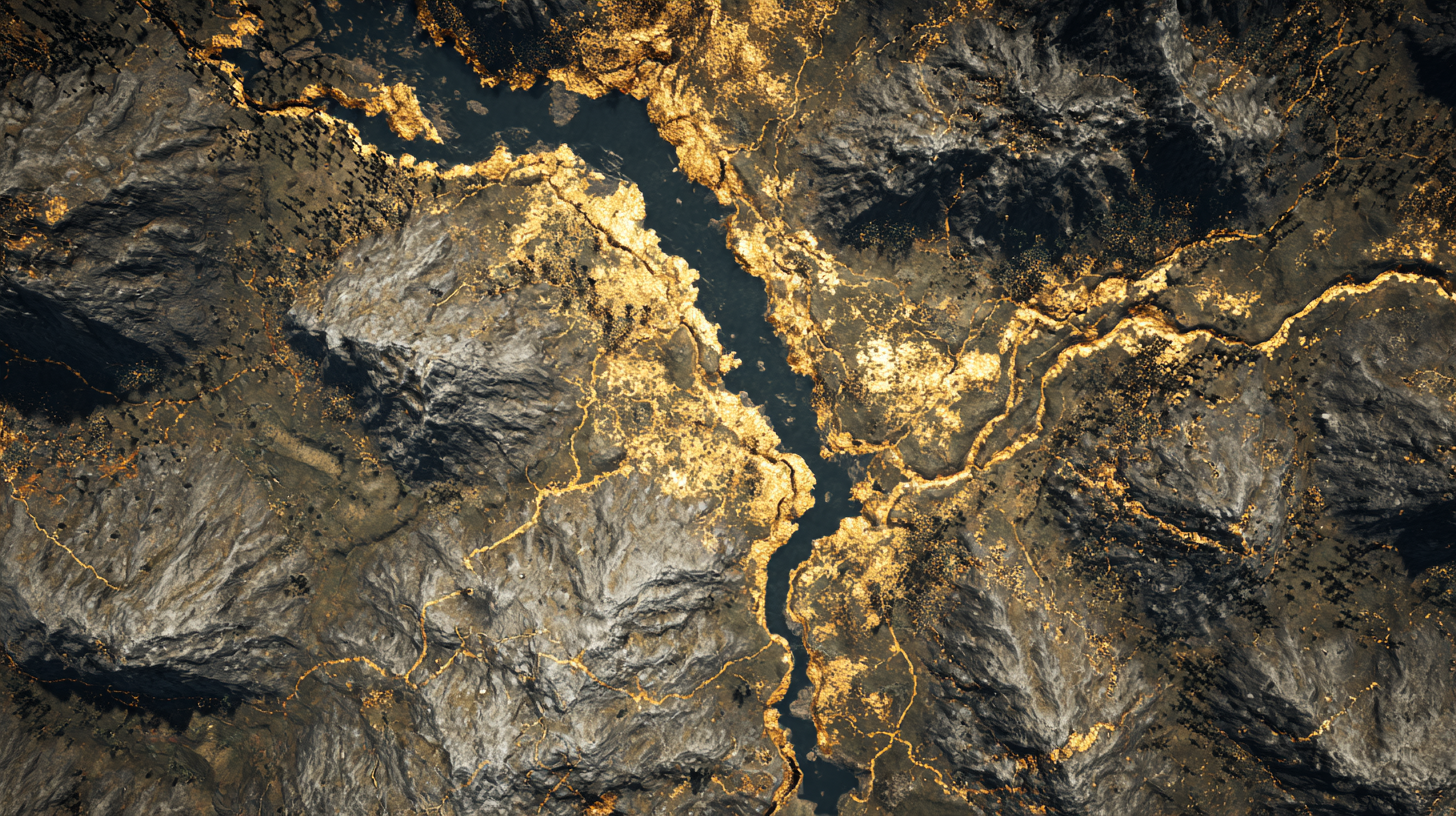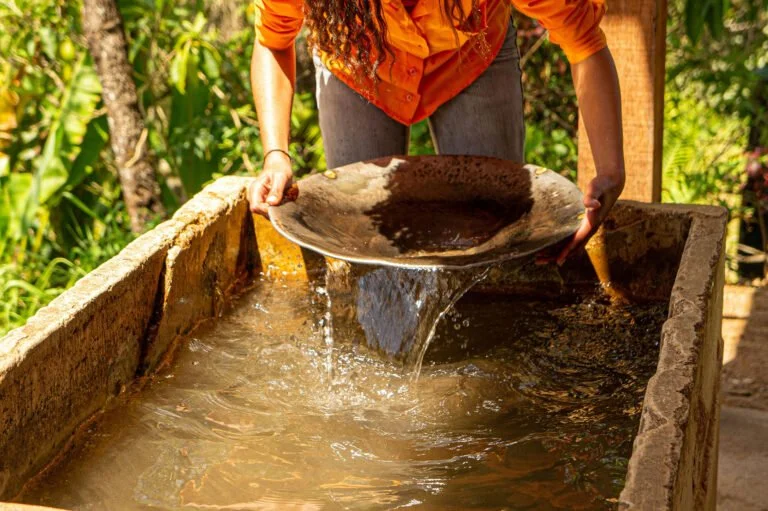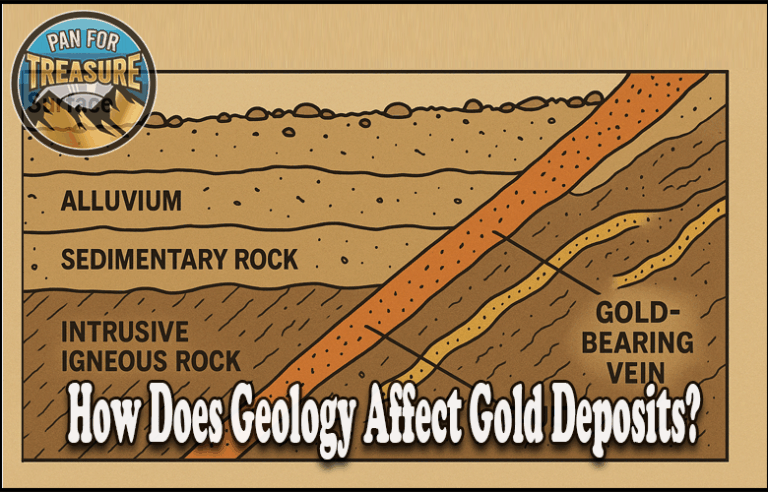Gold has captured the fascination of humans for centuries, and its value continues to endure. One of the most sought-after forms of gold is lode gold, which is found in veins and deposits. To successfully mine for this precious metal, it is crucial to understand the common locations where lode gold can be found.
First Posted August 24, 2025 | Last Updated on August 24, 2025 by Ryan ConlonDisclosure: This Post Contains Affiliate Links; We earn a commission on purchases.
Lode gold deposits are typically found in specific mining districts, geological formations, and vein systems. These locations provide favorable conditions for the formation of gold-bearing veins and mineralization. Host rocks, such as quartz veins and other rock formations, play a significant role in the occurrence of lode gold.
Key Takeaways:
- The common locations for lode gold include specific mining districts, geological formations, and vein systems.
- Host rocks, such as quartz veins, are often associated with lode gold deposits.
- Understanding the geology and mineralization processes can help identify potential lode gold locations.
- Lode gold deposits require targeted prospecting and mining techniques.
- Gold mines in the United States are often found in states like Alaska, California, Nevada, Colorado, and Arizona.
Formation of Gold and Its Distribution
Gold, a precious metal highly valued for its beauty and rarity, has a fascinating origin rooted in celestial events. It is believed to have formed through the collisions of supernovas and neutron stars billions of years ago, long before the formation of our solar system. Today, gold is accessed through various natural processes, including asteroid bombardment and volcanic activity.
Gold-bearing rocks play a crucial role in the formation and distribution of gold. One of the key geological processes responsible for the concentration of gold is the movement of heated fluids through the Earth’s crust. These fluids circulate through rock formations, picking up gold along the way and eventually depositing it in new locations, often in the form of quartz veins.
Earthquakes and shifting faults also contribute to the redistribution of gold. These geological events can cause the uplift and exposure of gold-bearing rocks, bringing them closer to the Earth’s surface. As a result, quartz veins, which often contain gold deposits, can be formed.
The distribution of gold in the Earth’s core and crust is a topic of ongoing scientific inquiry. While the exact mechanisms are not fully understood, gold is more commonly found at the edges of tectonic plates. These areas, known as plate boundaries, are characterized by intense geologic activity and are often associated with the formation of gold deposits.
In summary, the formation and distribution of gold are complex processes influenced by a combination of supernova collisions, geological processes like asteroid bombardment, volcanic activity, and the movement of fluids within the Earth’s crust. Understanding these processes is crucial in identifying potential locations for lode gold deposits and maximizing the chances of successful gold prospecting and mining.
Placer Gold Deposits
Placer gold deposits, also known as secondary gold deposits, are the easiest and most cost-effective deposits to mine. These deposits are formed when gold is eroded by weathering (temperature, wind, and water) from its source rocks. The gold is then flushed out and accumulates with other heavy minerals as fine gold dust or as small grains, also known as gold nuggets.
Placer deposits can be found in various locations, including stream beds, alluvial deposits, or even in the ocean. These alluvial deposits are formed when water, through its erosive power, washes away lighter materials, leaving behind the heavier gold particles. This natural process of weathering and erosion creates ideal conditions for placer gold to accumulate in concentrated quantities.
Some of the most productive placer deposits in the United States are found in Alaska and California‘s Sierra Nevada rivers. These regions have a long history of gold mining and have yielded significant amounts of placer gold over the years.
Placer gold mining involves various techniques, including panning, sluicing, and dredging. Miners search for areas where gold has been deposited and use these methods to extract the gold particles from the surrounding gravels and sediments.
Placer mining has been practiced for centuries and continues to be a viable method for gold extraction. Its simplicity and relatively low cost make it accessible to both large-scale mining operations and individual prospectors.
“Placer mining is like hunting for treasure in the great outdoors. It’s an adventure that brings together history, nature, and the thrill of finding gold particles sparkling in your pan.” – Experienced Placer Miner
Hard Rock Gold Deposits
Hard rock gold deposits, also referred to as lode gold deposits, are typically found within quartz veins and other rock formations. These deposits require more advanced mining techniques, such as underground mining, due to their location and geological characteristics. Hard rock deposits often contain other valuable metals like copper, silver, and lead alongside the gold.
When it comes to economically viable mining, the gold concentration in the ore body must exceed 2.5 grams per tonne. Quartz veins commonly found in hard rock deposits usually contain gold concentrations around one gram per tonne. Mining companies carefully assess the gold concentration and determine the feasibility of extraction.
Some of the most productive hard rock gold mines in the United States are located in South Dakota and Nevada. These regions have rich deposits of lode gold within their quartz veins and have been the focus of significant mining activities.
Characteristics of Hard Rock Gold Deposits
Hard rock gold deposits have distinct characteristics that set them apart from other types of gold deposits. These characteristics include:
- Quartz Veins: Hard rock deposits are typically associated with quartz veins, which serve as the primary host for gold mineralization.
- Underground Mining: Extracting gold from hard rock deposits often requires underground mining techniques to access the deep-lying ore bodies.
- Gold Concentration: The gold concentration in hard rock deposits is usually lower than that of placer deposits, requiring more extensive processing to extract the gold.
Understanding the unique characteristics of hard rock gold deposits is crucial for mining companies and prospectors seeking to tap into these reserves effectively.
“Hard rock gold deposits provide a significant challenge for miners due to their depth and complexity of extraction, but the rewards can be substantial.” – John Smith, Mining Geologist
Gold Deposit Types and Geological Characteristics
In the search for gold, it is crucial to understand the various types of gold deposits and their unique geological characteristics. This knowledge is essential in identifying and locating potential lode gold deposits. Let’s delve into the different types of gold deposits and their formations.
Epithermal Vein Deposits
Epithermal vein deposits are formed through hydrothermal systems near the Earth’s surface. These deposits often occur in volcanic regions and are associated with hot springs and geothermal activity. Hydrothermal fluids enriched with gold flow through fractures and faults, depositing gold in quartz veins. The veins usually have a high-grade gold content, making them attractive for mining.
Mesothermal Turbidite Deposits
Mesothermal turbidite deposits are found in sedimentary sequences and are associated with turbidity currents. These deposits occur in regions with tectonic activity and underwater landslides. Gold is transported by turbidity currents and concentrated in zones where sedimentary layers are disrupted. Mesothermal turbidite deposits often contain significant gold resources and require advanced mining techniques.
Skarn Deposits
Skarn deposits form in carbonate host lithologies adjacent to plutonic bodies. These deposits occur in contact metamorphic zones where hot hydrothermal fluids interact with limestone or dolomite. Skarn deposits are known for their diverse mineralization, including gold. They often accompany resources of other metals like copper, tungsten, and zinc. Mining skarn deposits requires careful exploration and extraction methods.
Disseminated Gold Deposits
Disseminated gold deposits are characterized by the spread of small gold particles throughout a host rock. These deposits can be found in a variety of geological settings, including volcanic rocks, sedimentary formations, and metamorphic rocks. Disseminated gold deposits may not exhibit the typical visible gold veins but can still contain significant gold resources. Mining these deposits requires careful extraction techniques to recover the fine particles of gold.
Understanding the different types of gold deposits and their geological characteristics is crucial in locating and identifying potential lode gold deposits.
Each type of gold deposit has its own specific formation processes, which are influenced by geological factors such as tectonic activity, volcanic processes, and hydrothermal systems. By studying these characteristics, geologists and prospectors can refine their exploration methods and increase their chances of finding viable gold deposits.
Distribution of Gold in the United States
Gold deposits in the United States are unevenly distributed, with the most productive regions being in Alaska, California, Nevada, Colorado, and Arizona. These areas are known for their rich mining districts and geological formations that host gold deposits.
The mountainous regions of these states, where folding, faulting, and igneous intrusions have deformed the rocks, are particularly productive for gold mining. The distribution and concentration of gold in these areas make them prime locations for lode gold deposits.
Gold Distribution in the United States
| State | Main Mining Districts |
|---|---|
| Alaska | Nome, Fairbanks, Juneau, Chicken |
| California | Sierra Nevada, Mother Lode Belt, East Fork of the San Gabriel River |
| Nevada | Carlin, Battle Mountain, Eureka |
| Colorado | Cripple Creek, Victor, Quartzville |
| Arizona | Superstition Mountains, Vulture Mine, Oatman |
These states not only have a history of successful gold mining but also offer ongoing opportunities for prospectors and mining companies. The availability of infrastructure, mining-friendly regulations, and established mining communities make these regions attractive for gold exploration and extraction.
The United States has a rich history of gold mining, and the distribution of gold deposits plays a significant role in determining the success of mining operations. Understanding the geology and mining districts in these states can guide prospectors and miners towards potential lode gold deposits.
Conclusion
Successful gold mining and prospecting requires a thorough understanding of the common locations for lode gold deposits. By studying geological formations, mining districts, and vein systems, prospectors can pinpoint potential areas where lode gold may be found. This knowledge is crucial in maximizing the efficiency and effectiveness of gold exploration and mining operations.
Different types of gold deposits, such as placer and hard rock deposits, present unique challenges and require specific mining methods. Placer gold deposits, found in stream beds and alluvial deposits, offer the advantage of easy accessibility and lower mining costs. On the other hand, hard rock gold deposits, located in quartz veins and other rock formations, necessitate more intensive underground mining techniques.
Considering the geological characteristics and distribution of gold in the United States is key to identifying the most productive regions for lode gold deposits. States like Alaska, California, Nevada, Colorado, and Arizona boast rich mining districts and geological structures that host abundant gold deposits. These areas, characterized by mountainous terrains and significant geological deformation, present prime opportunities for gold exploration and mining.
In conclusion, a comprehensive understanding of common locations for lode gold, geological formations, and mining methods is crucial in successful gold mining endeavors. By focusing efforts on the most promising regions and employing appropriate mining techniques, prospectors and miners can enhance their chances of discovering valuable lode gold deposits.

Meet Ryan Conlon, the passionate owner and driving force behind Pan for Treasure.
With an unwavering love for the art of gold panning, Ryan has transformed his enthusiasm into a thriving community hub for fellow treasure seekers. info@panfortreasure.com
A seasoned gold panning enthusiast, Ryan’s journey began with a simple pan and a dream, evolving into a deep appreciation for the history, geology, and thrill of uncovering precious metals.
Subscribe to Our Newsletter







